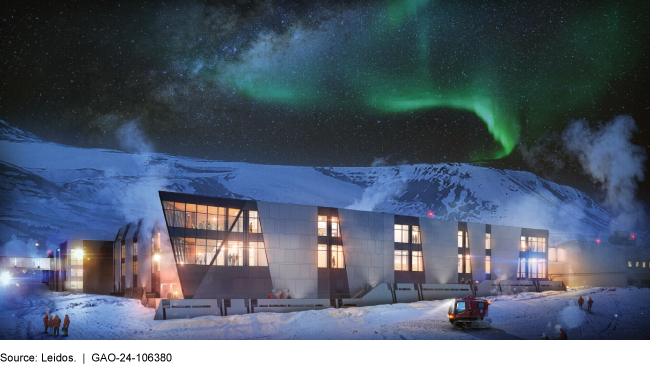National Science Foundation: Additional Steps Would Improve Cost Estimate for Antarctic Research Infrastructure Project
Fast Facts
The National Science Foundation funds and oversees the design, construction, and operations of science and engineering research infrastructure—like telescopes and research facilities. We report annually on these projects.
In July 2022, we reported that the pandemic led to cost increases and schedule delays for NSF's major facilities projects. NSF has decided to adjust the cost and schedule for 5 major projects—including a project to modernize the McMurdo research station in Antarctica.
NSF's revised cost estimate for the Antarctic project wasn't well documented and so couldn't be considered reliable. We recommended that NSF address this issue.
Rendering of the McMurdo Station at the Antarctic Infrastructure Modernization for Science Project

Highlights
What GAO Found
Since GAO's July 2022 report, the National Science Foundation (NSF) has finalized the cost and schedule increases that were due to the COVID-19 pandemic and other factors for all five major facilities projects in construction. NSF anticipates additional increases for two of its major facilities projects—the Vera C. Rubin Observatory and the Antarctic Infrastructure Modernization for Science. NSF also advanced the design of two projects and approved the advancement of two new projects to the design stage—the Giant Magellan Telescope, and the Thirty Meter Telescope.
Examples of National Science Foundation Major Facilities Projects

NSF's Antarctic Infrastructure Modernization for Science (AIMS) project substantially met three of the four characteristics of a reliable cost estimate and met all the characteristics of a reliable schedule. The AIMS cost estimate was unreliable because it did not substantially or fully meet all four characteristics of a reliable cost estimate, as described in GAO's cost guide. Specifically, the AIMS project partially met the “well-documented” characteristic associated with reliable cost estimates. This was, in part, because the estimate did not specify the source data used and it lacked details to trace technical baselines to cost and other key information for management review. Without good documentation, senior management and others providing oversight will not have confidence that the estimate is reliable. In addition, a reliable cost estimate may help the project to prevent any unnecessary tradeoffs or loss of research capabilities that may result from unexpected cost increases in the future.
NSF guidance requires that project teams identify all known risks and opportunities that may affect the supply chain for their projects in construction. Several projects have experienced unforeseen supply chain related risks due in part to the pandemic and other external factors. For example, the Rubin Observatory reported supply chain issues stemming from the war in Ukraine and the project's inability to receive shipments from that region to support construction. Because of the unforeseen nature of these risks, NSF determined that the agency would provide management reserve funds in response. To manage known supply chain risks, the award recipients may identify specific supplier performance and component availability for projects prior to construction and include in the project's budget contingency to respond to those risks should they occur.
Why GAO Did This Study
NSF supports the design, construction, and operations of science and engineering research infrastructure such as telescopes and research vessels. These projects include major facilities projects that cost over $100 million. Currently, NSF has five major facilities projects under construction at a combined authorized cost of $1.4 billion and four additional projects in design. Building these on time and within budget helps support the scientific community's ability to conduct research and advance U.S. scientific goals.
The Consolidated Appropriations Act, 2022, includes provisions for GAO to review projects funded from NSF's Major Research Equipment and Facilities Construction account. This report, the sixth, (1) describes the cost and schedule performance of NSF's research infrastructure projects, (2) examines the AIMS project's adoption of cost estimating and schedule development best practices and (3) examines supply chain risk management for NSF's major facilities projects in construction. GAO reviewed NSF and award recipient documents, examined policies and procedures to manage and oversee projects, and interviewed NSF officials.
Recommendations
GAO recommends that NSF ensure the AIMS project meets the well-documented characteristic of a reliable cost estimate. NSF concurred with the recommendation and noted it plans to develop a corrective action plan that will include appropriate measures for revised cost proposals for the project.
Recommendations for Executive Action
| Agency Affected | Recommendation | Status |
|---|---|---|
| National Science Foundation | The Director of NSF should ensure that the Antarctic Infrastructure Modernization for Science cost estimate meets the well-documented characteristic of a reliable cost estimate, as defined in GAO's cost guide. (Recommendation 1) |
When we confirm what actions the agency has taken in response to this recommendation, we will provide updated information.
|
